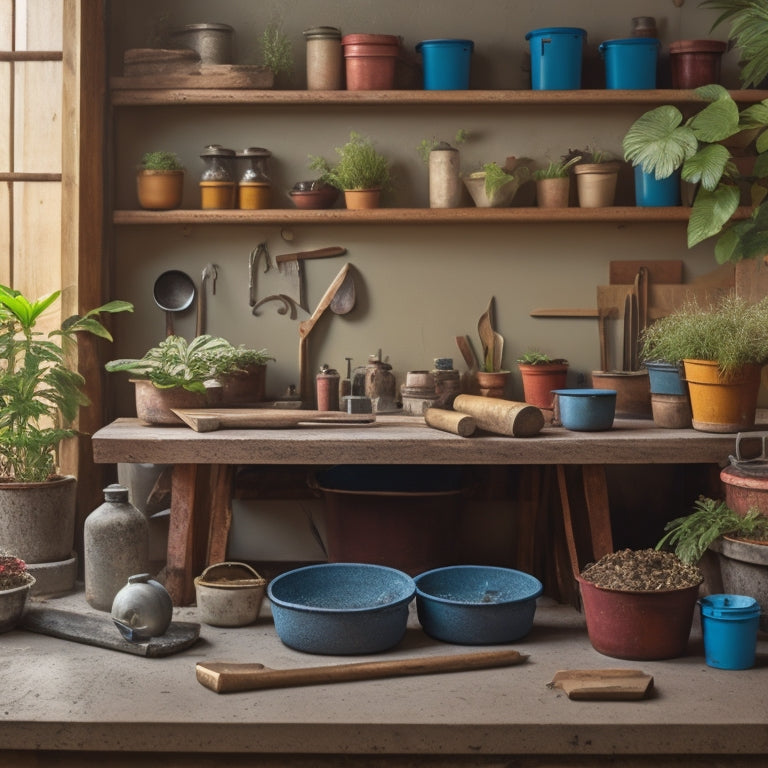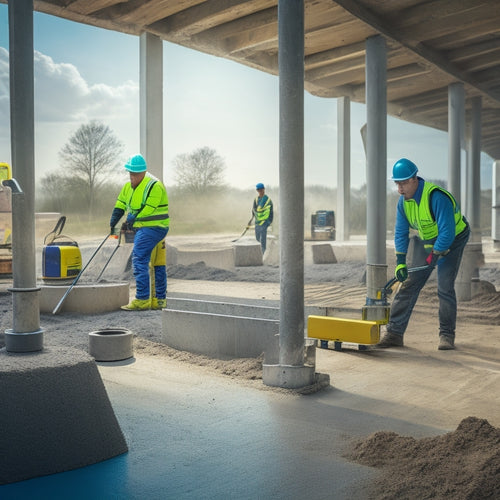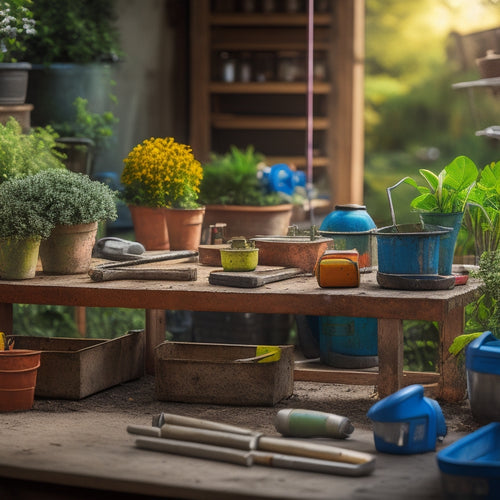
Why Choose the Right Tools for Concrete Planters
Share
When tackling a concrete planter project, you'll soon realize that choosing the right tools is essential for achieving a durable and visually stunning outcome. With the wrong tools, you risk surface imperfections, structural weaknesses, and even safety hazards. By selecting the right tools, you'll guarantee efficiency, effectiveness, and a high-quality finish. From essential safety gear to measuring and marking tools, concrete mixing and handling, and finishing and smoothening tools, each tool plays an important role in the construction process. By understanding the significance of proper tool selection, you'll be well on your way to creating a beautiful and long-lasting concrete planter that enhances your outdoor space.
Key Takeaways
- Proper tool selection ensures safety by preventing injuries and protecting against hazardous materials and environmental factors.
- Accurate measurements and markings are crucial for achieving precise designs, patterns, and structural integrity in concrete planters.
- The right tools enable efficient mixing, handling, and assembly of concrete, resulting in strong and durable planters.
- Specialized finishing and smoothening tools are necessary to achieve a professional, visually appealing finish and enhance planter durability.
- Choosing the right tools and materials helps reduce costs, saves time, and produces high-quality concrete planters that meet desired specifications.
Essential Safety Gear Checklist
When working with concrete, your DIY project can quickly turn into a hazardous endeavor without the right safety gear. Concrete dust and debris can cause serious eye injuries, so investing in protective eyewear is a must. Look for goggles or safety glasses with shatter-resistant lenses and a snug, comfortable fit.
Your hands are also at risk when working with concrete, as the alkaline properties can cause skin irritation and dryness. Durable gloves made from materials like nitrile or rubber can protect your skin from these harmful effects. Choose gloves with a textured palm for improved grip and dexterity.
In addition to eye and hand protection, consider wearing a dust mask or respirator to prevent inhaling concrete dust. A long-sleeved shirt, pants, and closed-toe shoes can also help prevent skin exposure.
Measuring and Marking Tools
When creating concrete planters, you'll quickly realize that precise measurement matters - a slight miscalculation can throw off the entire project.
To avoid costly mistakes, you'll need accurate marking essentials, like a reliable tape measure and a sharp pencil, to guarantee your design translates seamlessly from paper to planter.
Precise Measurement Matters
Accurate calculations and precise measurements lay the foundation for successful concrete planters, and that's where measuring and marking tools come into play.
You'll need to employ advanced measurement techniques to guarantee your planters turn out exactly as envisioned. Precision tools, such as digital calipers and laser levels, will become your trusted allies in this pursuit. With these tools, you'll be able to take precise readings and make accurate calculations, assuring a perfect fit for your concrete molds.
As you work with complex designs and intricate patterns, precision tools will help you navigate even the most challenging projects.
You'll be able to measure curves, angles, and shapes with ease, guaranteeing that every detail is meticulously captured. By combining advanced measurement techniques with precision tools, you'll open up a new level of accuracy and precision in your concrete planters.
The result? Stunning, professional-looking planters that showcase your craftsmanship and attention to detail.
Accurate Marking Essentials
Your measuring and marking tools are only as good as the marks they leave behind, and that's why having the right marking essentials is essential for achieving precision in your concrete planters.
When it comes to marking techniques, you need tools that can deliver accurate and consistent results. This is where high-quality marking gauges, layout squares, and precision markers come into play.
To guarantee your concrete planters turn out exactly as envisioned, you'll need:
- Laser levels to project precise leveling lines and guarantee your planters are perfectly aligned
- Marking gauges to create consistent, accurate markings for drilling, cutting, or other fabrication processes
- Layout squares to ensure precise 90-degree angles and prevent errors in your design
- Precision markers to create fine, accurate lines and markings that won't smudge or fade over time
Concrete Mixing and Handling
When you're working with concrete, getting the mix just right is essential, and you'll need to balance the ratio of cement, sand, and water to achieve the desired strength and texture.
You'll also need to handle fresh concrete with care, as it's sensitive to temperature, humidity, and vibration - all of which can affect its final form.
Mixing Ratio Matters
In the world of concrete planters, a delicate balance exists between durability and aesthetic appeal, and it all starts with the mixing ratio.
You're probably aware that concrete is a mixture of cement, water, and aggregate, but the proportions of each ingredient can make all the difference. Get it right, and you'll have a planter that's both strong and visually stunning. Get it wrong, and you'll end up with a brittle, crumbling mess.
Here are some key factors to evaluate when determining your mixing ratio:
-
Cement content: Higher cement content can improve durability, but it can also increase the risk of shrinkage and cracking.
-
Water-to-cement ratio: Too much water can lead to a weak, porous concrete, while too little water can make it difficult to mix and pour.
-
Aggregate size and type: The size and type of aggregate you use can affect the strength, texture, and appearance of your concrete.
- Environmental considerations: Using locally sourced, sustainable materials can reduce your carbon footprint and create a more eco-friendly planter.
Handling Fresh Concrete
Handling Fresh Concrete
Frequently, the mixing process itself can be just as essential as the mixing ratio, as it directly affects the quality of your fresh concrete. You'll want to verify you're handling it correctly to achieve the best results.
When mixing, you'll need to take into account the ideal temperature, which is between 50°F and 70°F (10°C and 21°C), as this allows for proper hydration and sets the stage for peak concrete curing.
Next, you'll need to prepare the surface where you'll be pouring the concrete. This involves thorough surface preparation, including clearing the area of debris and verifying it's level and even. You should also apply a release agent to prevent the concrete from sticking to the surface.
After pouring, you'll need to finish the concrete by tamping, floating, or troweling it to achieve the desired texture and finish.
Finally, let the concrete cure according to the manufacturer's instructions, taking care to maintain the right temperature and humidity levels.
Cinder Block Cutting Tools
Precision is key when working with concrete planters, and cutting cinder blocks to size is a crucial step in the process.
You'll need the right tools to achieve accurate cuts and guarantee your planter's structural integrity.
When it comes to cutting cinder blocks, you have several options:
-
Masonry saws: Ideal for making precise, straight cuts. They're available in electric and manual versions, so choose the one that suits your needs.
-
Circular saws with masonry blades: These are great for making curved or angled cuts. Just be sure to use a blade specifically designed for cutting concrete.
-
Demolition saws: Perfect for heavy-duty cutting and demolition work. They're powerful, but may not provide the most precise cuts.
- Hand saws or chisels: For smaller, more intricate cuts, or when you need more control over the cutting process.
Regardless of the tool you choose, it's important to master cutting techniques and maintain your tools properly to make sure they last and perform at their best.
Assembly and Leveling Tools
With your cinder blocks cut to size, it's time to bring your concrete planter together. Assembly and leveling tools are essential in guaranteeing your planter's structural integrity and aesthetic appeal.
You'll need a spirit level, a rubber mallet, and a notched trowel to achieve precise assembly techniques. The spirit level certifies your planter's sides are perfectly vertical, while the rubber mallet helps tap blocks into place without damaging them. The notched trowel is ideal for applying adhesive and creating a strong bond between blocks.
When it comes to leveling strategies, a laser level or a long spirit level will help you achieve a perfectly level surface. These tools enable you to identify any deviations from the horizontal plane, allowing you to make adjustments before the concrete sets.
Finishing and Smoothening Tools
You'll need to employ a range of specialized tools to refine your concrete planter's surface, ensuring it's both visually stunning and durable.
To achieve a smooth, even finish, you'll need to master various smoothing techniques.
- A steel trowel is essential for removing excess concrete, filling air pockets, and creating a uniform surface.
- A darby tool helps to flatten and smooth out the surface, eliminating any imperfections.
- A EDger or margin trowel is used to create clean, defined edges and corners.
- A finishing float is necessary for applying the final finishing touches, leaving your planter with a silky smooth surface.
Sealant and Adhesive Applications
Now that your concrete planter's surface is smooth and even, it's time to focus on protecting it from the elements and assembling its various components. Sealants and adhesives play an essential role in guaranteeing your planter's durability and longevity. You'll need to choose the right sealant type and adhesive properties to guarantee a strong bond between the planter's components.
| Sealant Type | Adhesive Properties | Recommended Use |
|---|---|---|
| Acrylic | Water-based, flexible, UV-resistant | General-purpose sealing, decorative elements |
| Silicone | Solvent-based, flexible, heat-resistant | High-temperature applications, outdoor use |
| Polyurethane | Solvent-based, strong, chemical-resistant | Bonding concrete to metal or wood |
| Epoxy | Solvent-based, strong, chemical-resistant | High-stress applications, industrial use |
When selecting a sealant or adhesive, consider factors like temperature resistance, chemical resistance, and flexibility. Make certain to follow the manufacturer's instructions for application and curing times to guarantee a strong, lasting bond. By choosing the right sealant and adhesive, you'll be able to create a durable, long-lasting concrete planter that will withstand the elements and remain a beautiful addition to your outdoor space.
Frequently Asked Questions
Can I Use Regular Gloves for Concrete Planter Projects?
You shouldn't use regular gloves for concrete planter projects, as they lack the necessary safety considerations; instead, opt for gloves made from durable, puncture-resistant materials like nitrile or Kevlar to protect your hands from abrasion and injury.
How Do I Prevent Concrete From Sticking to My Tools?
You'll be wrestling with concrete for hours if you don't take preventative measures! To avoid this nightmare, you'll need to master mixing techniques and prioritize tool maintenance - coating your tools with a release agent and cleaning them meticulously after each use is essential.
Are There Any Eco-Friendly Alternatives to Traditional Concrete?
You're exploring eco-friendly alternatives to traditional concrete, and rightly so! Look into sustainable materials like hempcrete, mycelium, or recycled aggregate; or biodegradable options like bamboo or coconut coir-based concretes, which reduce environmental impact while maintaining structural integrity.
Can I Use a Regular Drill for Mixing Concrete?
You've likely mixed a perfect cake batter with your drill, but concrete's a different beast. Using a regular drill can lead to uneven mixing, air pockets, and a weak planter. Invest in a heavy-duty drill with a mixing paddle and master mixing techniques for a sturdy, long-lasting concrete planter.
How Do I Store Leftover Concrete for Future Use?
When you're left with excess concrete, you'll want to master concrete storage techniques to reuse it later. You'll need airtight containers, like buckets or bags, to prevent moisture loss and contamination, ensuring your leftover concrete remains workable for future projects.
Conclusion
By choosing the right tools for your concrete planters, you'll avoid costly mistakes, guarantee a professional finish, and make the entire process more efficient. Without the correct gear, you'll be stuck with a messy, uneven, and potentially hazardous project. By investing in the essential tools outlined above, you'll be able to create stunning, long-lasting planters that bring beauty and functionality to any outdoor space.
Related Posts
-

Free Design Tools for Concrete House Planning
You can kick-start your concrete house planning project without breaking the bank, as there are several free design t...
-

What Tools Ensure Precise Concrete Leveling Results
You need a range of specialized tools to achieve precise concrete leveling results. Laser leveling instruments provid...
-

Must-Have Tools for Concrete Planter Projects
As you commence your concrete planter project, you'll need a range of specialized tools to achieve professional-grade...


